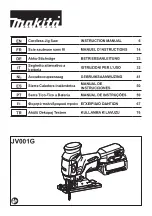
23
www.evolutionpowertools.com
EN
CROSSCUTTING
Set the Mitre Gauge to 0˚ and tighten the vertical
locking screw.
If employing the Sliding Carriage position the Mitre Gauge
in the LH ‘T’ slot and lock it in place by screwing the locking
screw into the locating hole.
Note:
The Mitre Gauge can be used on the RH side of the
blade if required. If so it will run ‘freely’ in the inverted ‘T’ slot
found on the RH side of the table.
Adjust the Mitre Gauge Face Plate to ensure clearance as it
passes the blade and blade guard during a cut.
Hold the material to be cut against the Mitre Gauge Faceplate.
Switch on the saw and allow to reach full operating speed
before sliding the mitre gauge and work-piece towards the
rear of the table making your cut
(Fig. 38)
.
MITRE CROSSCUTTING
Mitre crosscutting is cutting the work-piece at an angle of
other than 90˚. Set the Mitre Gauge to the desired angle
(Fig. 39)
, tighten and proceed as cross-cutting above.
BEVEL CROSSCUTTING
Bevel crosscutting is the same as crosscutting but with the
blade tilted at an angle.
Tilt the blade to the desired angle as previously described, and
ensure that it is locked in place.
Set the Mitre Gauge to 0˚ and adjust the faceplate so that it will
not touch or foul the saw blade or blade guard as it
travels past.
Hold the work-piece against the Mitre Gauge and make
your cut
(Fig. 40)
.
COMPOUND MITRE CUTTING
Compound mitre cutting is a combination of mitre cutting and
bevel crosscutting.
Adjust the mitre gauge and the blade to the desired angles.
Lock both in place.
Check that the mitre gauge will pass the saw blade without
fouling. Adjust the mitre gauge faceplate if necessary.
Index the material against the mitre gauge and make your
cut
(Fig. 41)
.
Fig. 38
Fig. 39
Fig. 40
Fig. 41






































